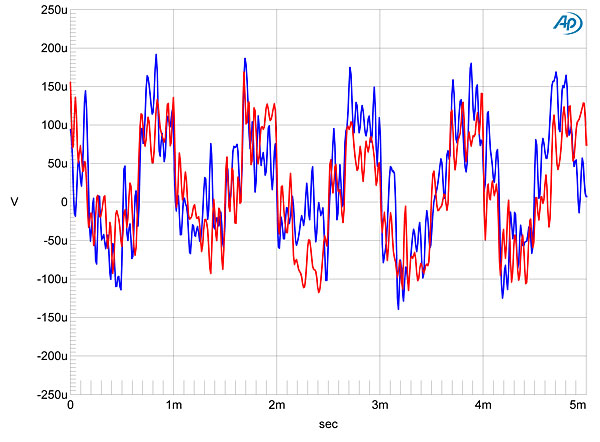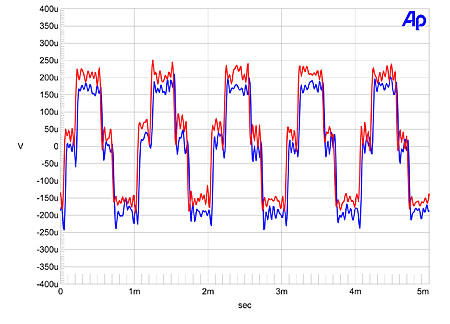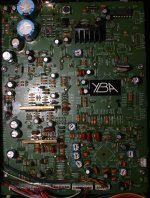Member
Joined 2009
Paid Member
I browsed the French forums a bit to gather more about the YBA players. From the picture, yours is a CD3, right ? The manufacturer is very secretive about what's inside, the dac are supposedly 18bits "custom modified". Doesn't help much...
I wish it were a CD3 but that was too expensive at the time. Mine is a Lecteur CD and it is easily upgradeable to a CD1 / CD2 by adding an external power supply. I bought it before I was into DIY, nowadays I could readily tackle the design and build of an external power supply so I could also do an upgrade. However, the top of the case is hard to remove, the screws holding it on are a proprietary design and I have nothing suitable to remove them. They look like Torx screws with a centre-pin and I read on the internet that there is a way to get them out so I may try.
Last edited:
Those are security torx and there are bits available for them.
e.g. Set 9 security(pinned)Torx screwdriver bits 25mm long | eBay
e.g. Set 9 security(pinned)Torx screwdriver bits 25mm long | eBay
Member
Joined 2009
Paid Member
- If you search the forum, you'll find a thread about the listening tests made by national semi in the development of their last generation of opamps. National Semi had a pair of Watt Puppy and a pair of B&W 802D in house for such evaluation btw.
I was already aware of that - opamps aren't DACs which is the current context. That's also history - they are no longer targetting the audio market in my understanding. Audioman54 is a DIYA member and has detailed his experience here.
- If you open the opa604 datasheet, you'll find a section dedicated to sound quality.
Been there, read the datasheet. Note that was in the days of Burr Brown which has since been absorbed into TI so again, history.
You can also read the AN-1490 from TI, about the lm4702. They detail how they polished the design through critical listening tests, to establish the best sounding bias point and the best parts. This again shows how listening tests for best sound quality are part of the development process at a major manufacturer.
Again not current context (not DACs) and it shows that for that product listening tests were (not are) used.
<edit> The quote from AKM is fair - yet its from the manufacturer so not likely to be impartial. So we have a claim (not evidence) that AKM is doing listening and feeding back the results of their listening into the chip designers. At least the claim is promising but AKM is hardly the whole industry.
Last edited:
So opamps and dac are from a different industry ? That's new to me. Completely fair game, especially given the fact that opamps are subject to the same obsession about numbers.I was already aware of that - opamps aren't DACs which is the current context. That's also history - they are no longer targetting the audio market in my understanding. Audioman54 is a DIYA member and has detailed his experience here.
As for the fact that it is "history": it wasn't when the industry made the shift to sigma-delta. So it's relevant to the (out-)topic at hand.
See above. And the top sigma delta DAC from TI trace their development back to Burr Brown.Been there, read the datasheet. Note that was in the days of Burr Brown which has since been absorbed into TI so again, history.
Sufficient to counter your wide claims about the industry. And I fail to see what you want to establish with your distinction in between were and are.Again not current context (not DACs) and it shows that for that product listening tests were (not are) used.
Btw, if you're doing your homework, you'll see TI's datasheets and app notes from their analog section are littered with references to listening tests. Similar stuff can be found in Analog Devices' datasheets. There's enough evidence that the common industry practice includes listening tests to put hearsay from one engineer from Cirrus in perspective.
So you might not agree with the evaluation of sound quality by the industry but to claim that they (as a whole) only design by numbers is complete garbage.
Furthermore, you acknowledge the fact that people in the recording industry listen to the gear they buy. If the old technology was so much better, there should be nostalgia about the good old times of the 90's. There might be but it isn't about the digital gear. On a forum like groupdiy, there's a lot of activity to recreate old mic preamps and the like... not so much activity about digital and the consensus is that the current crop of equipment is much better than what used to be available. If the differences in sound were as big as you claim, they should jump to the pros' ears. Clearly they don't. But they don't listen to 100$ speakers either. 🙄
So opamps and dac are from a different industry ?
Nope. The distraction is noted 🙂
The existence of listening tests in the industry isn't disputed by me. You've not produced any evidence that design is done other than by numbers. ESS being the exception based on Martin Mallinson has revealed.Btw, if you're doing your homework, you'll see TI's datasheets and app notes from their analog section are littered with references to listening tests. Similar stuff can be found in Analog Devices' datasheets. There's enough evidence that the common industry practice includes listening tests to put hearsay from one engineer from Cirrus in perspective.
Furthermore, you acknowledge the fact that people in the recording industry listen to the gear they buy. If the old technology was so much better, there should be nostalgia about the good old times of the 90's.
You seem here to be missing the point. Technology doesn't become good simply because its old. Nor is any new technology dissed simply because its new.
Which claim of differences are you referring to here?If the differences in sound were as big as you claim, they should jump to the pros' ears.
You can order it up as a kit or finished, boxed DAC. The link's on my blog - but they're quoting quite a long lead time it seems (at least 15days).
Hi and thanks i will look there for sure.
Yes, because in today's market 'top quality' means 'best numbers' rather than 'best sound'. As 00940 says the prevailing view in the industry is the same as his - that numbers (THD+N, bits) are enough to say whether a DAC's decent or not and people's listening impressions don't really matter because they're just subjective opinions
I see but i cannot think to the professionals. For them sound quality i guess is very important and i see them using recent dacs and not vintage ones.
Another point is now clear to me. That the dac chip is just a part of the whole.
I have already been told that different dacs build around the same dac chip can sound hugely different in quality.
Still this tendency of using old dac chips must have some reasons.
Thanks again, gino
It has been my experience that the professional designers do in fact listen extensively, and are quite prone to set up listening panels and such (Often with proper controls, randomization and blinding).
The "Engineer who only cares about the numbers" is in my experience a straw man, I am pretty sure all product designers listen. Everyone knows that audio is subtle, and while we can pretty much always (eventually) measure the differences when the panel comes back with something having a meaningful p value, they may well not have been things that were originally checked for.
THD+N has never been an adequate way to quantify a part, for all that it is easy to measure, and everyone designing professional gear knows it (Its usefulness is in providing an early check that things are not horrible, it does not suffice to say that things are right).
One further note on the whole DS noise modulation subject, essentially ALL of the ADCs used in the recording process (Or master digitization process for that matter) are delta sigma parts.....
Regards, Dan.
The "Engineer who only cares about the numbers" is in my experience a straw man, I am pretty sure all product designers listen. Everyone knows that audio is subtle, and while we can pretty much always (eventually) measure the differences when the panel comes back with something having a meaningful p value, they may well not have been things that were originally checked for.
THD+N has never been an adequate way to quantify a part, for all that it is easy to measure, and everyone designing professional gear knows it (Its usefulness is in providing an early check that things are not horrible, it does not suffice to say that things are right).
One further note on the whole DS noise modulation subject, essentially ALL of the ADCs used in the recording process (Or master digitization process for that matter) are delta sigma parts.....
Regards, Dan.
Hi ... my biggest problem with digital is to accept that this is a sinewave - needless to say that i do not like its shape at all mainly because it hardly resembles the input waveform.
Just that ...

taken from here
Abbingdon Music Research DP-777 D/A processor Measurements | Stereophile.com
regards, gino
Just that ...

taken from here
Abbingdon Music Research DP-777 D/A processor Measurements | Stereophile.com
regards, gino
I see but i cannot think to the professionals. For them sound quality i guess is very important and i see them using recent dacs and not vintage ones.
Sound quality is important yes, but other factors are also important, often more so. For example ability to support the formats their customers are asking for is crucial. The newer chips support longer bit lengths and higher sample rates (upto DXD) and also various flavours of DSD which old ones don't.
Another point is now clear to me. That the dac chip is just a part of the whole.
I have already been told that different dacs build around the same dac chip can sound hugely different in quality.
Right - so just using a 'vintage' chip even if one could be reliably sourced wouldn't necessarily get a DAC into audio nirvana.
Still this tendency of using old dac chips must have some reasons.
Its a distraction to refer to them as 'old chips' - their distinguishing feature isn't their age, rather the architecture they employ. There's a recent example - the Schitt Yggy DAC which is using a multibit DAC which is a brand new chip design from ADI. About 3 years ago Metrum introduced the Octave which uses a resistor string DAC. Those who love sound quality and don't care about its relatively poor numbers have been waxing lyrical about that design ever since.
That plot is with an input 90dB down on full scale in a unit running in 16 bit mode....
Of course it is in the noise floor, where would you expect it to be?
Regards, Dan.
Of course it is in the noise floor, where would you expect it to be?
Regards, Dan.
As dmills points out, that's a sinewave about 3dB above the broadband noise floor. I'd be more concerned about fig21 in that test suite myself which shows only 2dB or (at a pinch) 3dB suppression of the images of the IMD test tones above 22kHz 😱
Last edited:
Sound quality is important yes, but other factors are also important, often more so. For example ability to support the formats their customers are asking for is crucial. The newer chips support longer bit lengths and higher sample rates (upto DXD) and also various flavours of DSD which old ones don't.
Hi and point taken. They have to please the customers this is clear.
Right - so just using a 'vintage' chip even if one could be reliably sourced wouldn't necessarily get a DAC into audio nirvana.
Its a distraction to refer to them as 'old chips' - their distinguishing feature isn't their age, rather the architecture they employ.
There's a recent example - the Schitt Yggy DAC which is using a multibit DAC which is a brand new chip design from ADI. About 3 years ago Metrum introduced the Octave which uses a resistor string DAC.
Those who love sound quality and don't care about its relatively poor numbers have been waxing lyrical about that design ever since
Now you have triggered my curiosity a lot.
I guess you are referring to this dac chip in the video ?
https://www.youtube.com/watch?v=qI-fC55KZkI
really expensive part i understand.
I will read more on the subject.
Thanks a lot again, gino
That plot is with an input 90dB down on full scale in a unit running in 16 bit mode....
Of course it is in the noise floor, where would you expect it to be?
Regards, Dan
Hi well i have seen better shapes just that. Like this one ... not perfect but better
http://www.stereophile.com/images/archivesart/509Camfig06.jpg

I understand that is very low level by the way.
regards, gino
I guess you are referring to this dac chip in the video ?
I dunno - here in China youtube isn't permitted. I have a posting about the Yggy DAC on my blog, along with the DS for the chip its using. Very interesting new design to be sure - one for the listeners rather than the meter readers 🙂
<edit> That second waveform you've posted is going to be coming from a DAC with a much lower noise floor than the first. Probably not a 16bit DAC. Which review is it from incidentally?
Last edited:
If that is measured at the analogue output then somebodies dither or reconstruction filter is very, very broken.
I would guess 16 bits, undithered @ -90dBFs or so, undithered quantisers are broken pretty much by definition.
The first plot is actually likely to be better, as it at least shows evidence of noise shaped dither.
Regards, Dan.
I would guess 16 bits, undithered @ -90dBFs or so, undithered quantisers are broken pretty much by definition.
The first plot is actually likely to be better, as it at least shows evidence of noise shaped dither.
Regards, Dan.
Last edited:
I dunno - here in China youtube isn't permitted. I have a posting about the Yggy DAC on my blog, along with the DS for the chip its using. Very interesting new design to be sure - one for the listeners rather than the meter readers 🙂
I have read something and the part is expensive (like 100USD/each) and it has not been designed with audio in mind but it is a high precision part.
I think that some exceptional products can be helpful because they hint at what is needed to get excellent sound.
I just hope that similar performance could be available in the future for less money.
But this product seems to have the potential to redefine the market.
<edit> That second waveform you've posted is going to be coming from a DAC with a much lower noise floor than the first. Probably not a 16bit DAC. Which review is it from incidentally?
this one here Cambridge Audio Azur DacMagic D/A converter Measurements | Stereophile.com
I have it and it is not bad. But always looking for something better than can connect me more with the music
thanks again, gino
Ah WM8740 DAC - you could always improve the power supply to that chip. I got some improvements to mine by putting several X7R 10uF ceramics across the top of the chip, on the analog supplies. Still didn't make it as natural sounding as a TDA1387 but it was a worthwhile step up.
- Home
- Source & Line
- Digital Source
- adding digital input to a YBA CD player for use as a DAC ?
